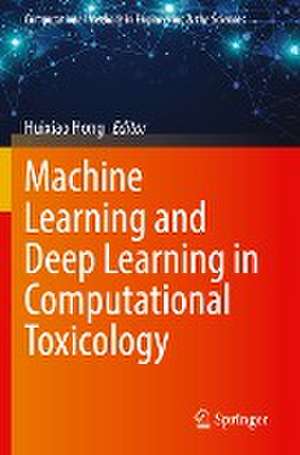Machine Learning and Deep Learning in Computational Toxicology: Computational Methods in Engineering & the Sciences
Editat de Huixiao Hongen Limba Engleză Paperback – 8 feb 2024
| Toate formatele și edițiile | Preț | Express |
|---|---|---|
| Paperback (1) | 1015.22 lei 38-44 zile | |
| Springer International Publishing – 8 feb 2024 | 1015.22 lei 38-44 zile | |
| Hardback (1) | 1043.50 lei 38-44 zile | |
| Springer International Publishing – 8 feb 2023 | 1043.50 lei 38-44 zile |
Preț: 1015.22 lei
Preț vechi: 1068.66 lei
-5% Nou
Puncte Express: 1523
Preț estimativ în valută:
194.32€ • 211.15$ • 163.34£
194.32€ • 211.15$ • 163.34£
Carte tipărită la comandă
Livrare economică 17-23 aprilie
Preluare comenzi: 021 569.72.76
Specificații
ISBN-13: 9783031207327
ISBN-10: 3031207327
Pagini: 635
Ilustrații: XIX, 635 p. 149 illus., 124 illus. in color.
Dimensiuni: 155 x 235 mm
Ediția:1st ed. 2023
Editura: Springer International Publishing
Colecția Springer
Seria Computational Methods in Engineering & the Sciences
Locul publicării:Cham, Switzerland
ISBN-10: 3031207327
Pagini: 635
Ilustrații: XIX, 635 p. 149 illus., 124 illus. in color.
Dimensiuni: 155 x 235 mm
Ediția:1st ed. 2023
Editura: Springer International Publishing
Colecția Springer
Seria Computational Methods in Engineering & the Sciences
Locul publicării:Cham, Switzerland
Cuprins
Machine Learning and Deep Learning Promotes Predictive Toxicology for Risk Assessment of Chemicals.- Multi-Modal Deep Learning Approaches for Molecular Toxicity prediction.- Emerging Machine Learning Techniques in Predicting Adverse Drug Reactions.- Drug Effect Deep Learner Based on Graphical Convolutional Network.- AOP Based Machine Learning for Toxicity Prediction.- Graph Kernel Learning for Predictive Toxicity Models.- Optimize and Strengthen Machine Learning Models Based on in vitro Assays with Mecha-nistic Knowledge and Real-World Data.- Multitask Learning for Quantitative Structure-Activity Relationships: A Tutorial.- Isalos Predictive Analytics Platform: Cheminformatics, Nanoinformatics and Data Mining Applications.- ED Profiler: Machine Learning Tool for Screening Potential Endocrine Disrupting Chemicals.- Quantitative Target-specific Toxicity Prediction Modeling (QTTPM): Coupling Machine Learning with Dynamic Protein-Ligand Interaction Descriptors (dyPLIDs) to Predict Androgen Receptor-mediated Toxicity.- Mold2 Descriptors Facilitate Development of Machine Learning and Deep Learning Models for Predicting Toxicity of Chemicals.- Applicability Domain Characterization for Machine Learning QSAR Models.- Controlling for Confounding in Complex Survey Machine Learning Models to Assess Drug Safety and Risk.
Notă biografică
Huixiao Hong is a Senior Biomedical Research and Biomedical Product Assessment Service (SBRBPAS) expert and the chief of Bioinformatics Branch, Division of Bioinformatics and Biostatistics, National Center for Toxicological Research, US Food and Drug Administration (FDA), working on the scientific bases for regulatory applications of bioinformatics, cheminformatics, artificial intelligence, and genomics. Before joining the FDA, he was the manager of Bioinformatics Division of Z-Tech, an ICFI company. He held a research scientist position at Sumitomo Chemical Company in Japan and was a visiting scientist at National Cancer Institute at National Institutes of Health. He was also an associate professor and the director of Laboratory of Computational Chemistry at Nanjing University in China. Dr. Hong is a member of steering committee of OpenTox, a member of the board directors of US MidSouth Computational Biology and Bioinformatics Society, and in the leadership circle of US FDA modeling and simulation working group. He published more than 240 scientific papers with a Google Scholar h-index 60. He serves as an associate editor for Experimental Biology and Medicine and an editorial board member for multiple peer-reviewed journals. He received his Ph.D. from Nanjing University in China and conducted research in Leeds University in England.
Textul de pe ultima copertă
This book is a collection of machine learning and deep learning algorithms, methods, architectures, and software tools that have been developed and widely applied in predictive toxicology. It compiles a set of recent applications using state-of-the-art machine learning and deep learning techniques in analysis of a variety of toxicological endpoint data. The contents illustrate those machine learning and deep learning algorithms, methods, and software tools and summarise the applications of machine learning and deep learning in predictive toxicology with informative text, figures, and tables that are contributed by the first tier of experts. One of the major features is the case studies of applications of machine learning and deep learning in toxicological research that serve as examples for readers to learn how to apply machine learning and deep learning techniques in predictive toxicology. This book is expected to provide a reference for practical applications of machine learning anddeep learning in toxicological research. It is a useful guide for toxicologists, chemists, drug discovery and development researchers, regulatory scientists, government reviewers, and graduate students. The main benefit for the readers is understanding the widely used machine learning and deep learning techniques and gaining practical procedures for applying machine learning and deep learning in predictive toxicology.
Caracteristici
Covers comprehensive view of the machine learning and deep learning algorithms, methods, and software tools Provides many practical applications of machine learning and deep learning techniques in predictive toxicology Presents numerous figures to detail the diverse procedures used for variety of machine learning and deep learning




